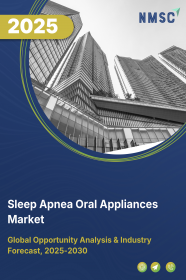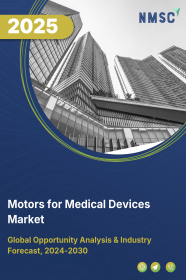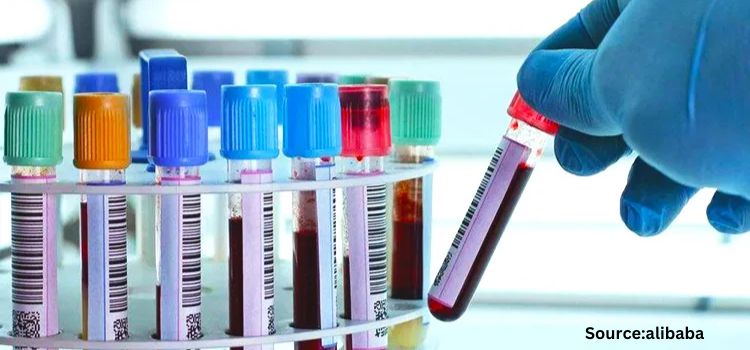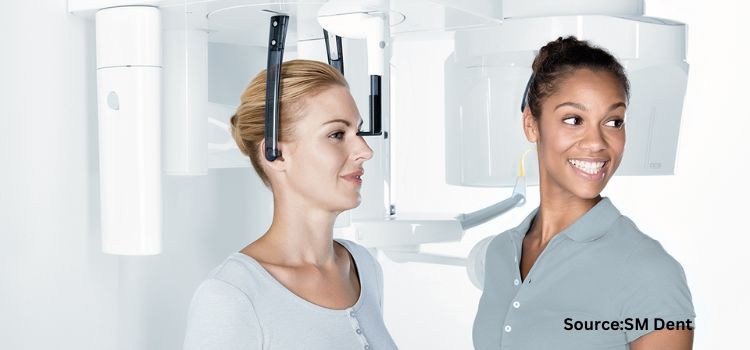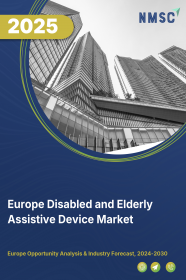
Europe Disabled and Elderly Assistive Device Market by Type (Mobility Impairments, Hearing Impairments, Visual Impairments, Cognitive Impairments, and Self-Care), and by End User (Hospitals, Elderly Nursing Homes, Home Care, and Other End User) –Opportunity Analysis and Industry Forecast, 2024 – 2030
Industry: Healthcare | Publish Date: 17-Feb-2025 | No of Pages: 179 | No. of Tables: 142 | No. of Figures: 87 | Format: PDF | Report Code : HC1071
Europe Disabled & Elderly Assistive Device Market Overview
The Europe Disabled & Elderly Assistive Device Market size was valued at USD 12.01 billion in 2023, and is predicted to reach USD 26.06 billion by 2030, at a CAGR of 10.7% from 2024 to 2030.
The disabled & elderly assistive device market refers to a wide range of products and services designed to support the aging population and individuals with disabilities in maintaining their autonomy and improving their quality of life. This market covers medical furniture, hearing aids, mobility aids and living aids, that are crucial for managing chronic conditions and ensuring safety.
Innovations in these areas are driven by the need to address the growing challenges of an aging population and the diverse requirements of individuals with disabilities, making this market integral to enhancing accessibility and wellbeing. This market is fueled by growing rate of disabled individuals, rapid technological advancements, and evolving regulatory landscapes, the assistive device industry prioritizes inclusivity and continuously adapts to meet the ever-changing needs of its diverse user base.
The Growing Aging Population Drives the Demand for Assistive Devices
The aging population in Europe is driving demand for assistive devices due to increasing life expectancy and higher prevalence of age-related conditions. This demographic shift necessitates device such as mobility aids and vision enhancements to maintain autonomy and improve quality of life.
According to the European Commission 2023, the European Union (EU) population estimated at 448.8 million and more than 21.3% of people aged 65 years and over. This demographic trend creates demand for advanced assistive device, driving innovation and investment in improving accessibility and affordability across the region.
The Rising Prevalence of Disabilities Fuels the Europe Disabled & Elderly Assistive Device Market Growth
The increasing prevalence of disabilities and elderly populations across Europe drives the demand for assistive devices. As the number of people affected by age-related conditions and disabilities rises, there is a growing need for innovative assistive device that enhance mobility, sensory capabilities, and overall quality of life.
According to the Eurostat report 2024, the disability rate of Denmark stood at 36.1% among the overall population. Moreover, Portugal stood at 34.0%, Finland stood at 33.9%, Netherland stood at 32.3%, and Spain and Germany stood at 30.4%. This trend underscores the significance of advancements in devices such as mobility aids, home care device, and personalized medical devices tailored to meet diverse needs. Governments and healthcare providers are focusing on improving accessibility and affordability of these devices to ensure widespread adoption and support across Europe's aging population.
The Regulatory Challenges Hinders the Growth of the Market
The European disabled & elderly assistive device market faces significant regulatory challenges that restrain growth and innovation. Regulatory bodies such as the European Medicines Agency (EMA) Medicines, Eye Movement Desensitization and Reprocessing (EMDR), Healthcare products Regulatory Agency (MHRA), Major Depressive Disorder (MDD), In Vitro Diagnostic Regulation (IVDR), and other national agencies impose stringent approval processes, requiring assistive products, especially medical devices, to undergo extensive testing and certification before entering the market. This ensures safety and efficacy but delays product launches and elevate costs significantly.
The Integration of AI Into Assistive Device is Expected to Create Ample Growth Opportunity for the Market
The integration of assistive technologies such as artificial intelligence (AI) and advanced sensors into disabled & elderly assistive devices represents a transformative leap towards a future where these devices are not only more advanced but also more personalized and accessible than ever before.
AI enables assistive device to evolve beyond static solutions, becoming dynamic and adaptable to the specific needs of each user. Through machine learning algorithms, these devices learn from user interactions, continuously improving their functionality and responsiveness.
Germany Dominates the Europe Disabled & Elderly Assistive Device Market Share
Government policies and reimbursement schemes in Germany significantly drive the disabled & elderly assistive device market. Financial support through programs such as the Pflegeversicherung also known as long-term care insurance helps to cover the costs of assistive device for those in need. The Pflegeversicherung covers healthcare expenses for individuals in old age, costing up to 4% of their income. This reduces the financial burden on individuals and families, making it easier for them to acquire essential devices.
Moreover, Germany's substantial healthcare expenditure significantly propels the disabled & elderly assistive device market by facilitating extensive investments in healthcare infrastructure and advanced medical device. With healthcare expenditures ranking among the highest, Germany allocates a significant portion of its GDP to healthcare, ensuring robust funding for the integration and development of assistive devices.
According to the European Commission 2024 report, Germany recorded the highest healthcare expenditure among the EU member that accounted for USD 536.97 billion in 2021. Germany's substantial healthcare expenditure supports growth in assistive device, fostering innovation and improving accessibility for seniors and individuals with disabilities.
Sweden to Witness Substantial Growth in the Europe Region
Sweden's transition towards aging population is driving the Europe disabled & elderly assistive device market demand. As population ages, the demand for device and devices designed to address age-related health conditions and enhance independence among older individuals increases. According to the European Commission report 2024, in Sweden the share of population aged 80 years and over stood at 5.5% in 2023 compared to Norway that is 4.5%. This demographic shift is prompting greater investment and innovation in assistive device such as mobility aids, sensory devices, and home care systems.
Moreover, Sweden's substantial investment in healthcare is pivotal in stimulating demand for assistive devices. With a significant allocation of its GDP, Sweden ensures ample funding for healthcare infrastructure, services, and advanced medical device. According to the European Commission report 2024, through healthcare expenditure Sweden contributed 11.2% toward its GDP as compared to Finland that contributed 10.1%. This financial dedication fosters the development and accessibility of a diverse array of assistive devices aimed at enhancing the quality of life for elderly and disabled individuals.
Competitive Landscape
The promising players operating in the Europe disabled & elderly assistive device industry includes Ottobock SE & Co. KGaA, Invacare Corporation, Sunrise Medical LLC, Permobil AB, Drive DeVilbiss Healthcare, Medline Industries, Inc., Thuasne, Pride Mobility Products Corp., Baxter, Savaria Corporation, William Demant Holding A/S, Stryker Corporation, GN Resound Group, Sonova Holding AG, AddLife AB, and others.
Europe Disabled & Elderly Assistive Device Market Key Segments
By Type
-
Mobility Impairments
-
Wheelchairs
-
Walkers and Rollators
-
Canes and Walking Sticks
-
Crutches
-
Portable Ramps
-
Others
-
-
Hearing Impairments
-
Hearing aids
-
FM System
-
Deafblind communicators for hearing
-
-
Visual Impairments
-
Screen readers
-
Optical magnifiers
-
Smart phones for vision
-
Braille writing equipment
-
Talking Devices
-
-
Cognitive Impairments
-
Self-Care
-
Shower Chairs
-
Grab-bars/handrails
-
By End User
-
Hospitals
-
Elderly Nursing Homes
-
Home Care
-
Other End Users
By Country
-
UK
-
Germany
-
France
-
Italy
-
Spain
-
Denmark
-
Netherlands
-
Finland
-
Sweden
-
Norway
-
Russia
-
Rest of Europe
Key Players
-
Ottobock SE & Co. KGaA
-
Invacare Corporation
-
Sunrise Medical LLC
-
Permobil AB
-
Drive DeVilbiss Healthcare
-
Medline Industries, Inc.
-
Thuasne
-
Pride Mobility Products Corp.
-
Baxter
-
Savaria Corporation
-
William Demant Holding A/S
-
Stryker Corporation
-
GN Resound Group
-
Sonova Holding AG
-
AddLife AB
REPORT SCOPE AND SEGMENTATION:
|
Parameters |
Details |
|
Market Size Value in 2023 |
USD 12.01 billion |
|
Revenue Forecast in 2030 |
USD 26.06 billion |
|
Value Growth Rate |
CAGR of 10.7% from 2024 to 2030 |
|
Analysis Period |
2023–2030 |
|
Base Year Considered |
2023 |
|
Forecast Period |
2024–2030 |
|
Market Size Estimation |
Billion (USD) |
|
Growth Factors |
|
|
Companies Profiled |
10 |
|
Countries Covered |
12 |
|
Customization Scope |
Free customization (equivalent up to 80 working hours of analysts) after purchase. Addition or alteration to country, regional, and segment scope. |
|
Pricing and Purchase Options |
Avail customized purchase options to meet your exact research needs |

















 Speak to Our Analyst
Speak to Our Analyst



